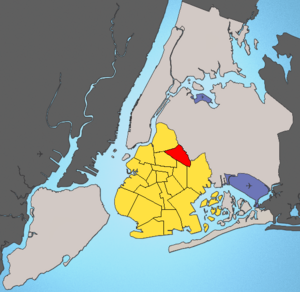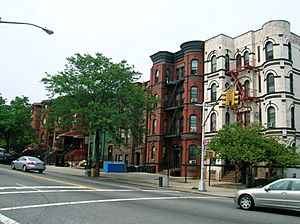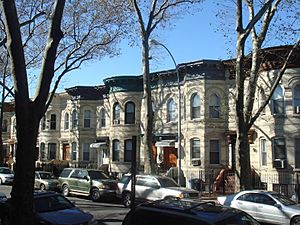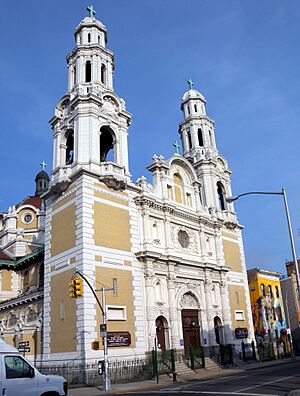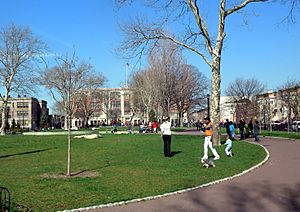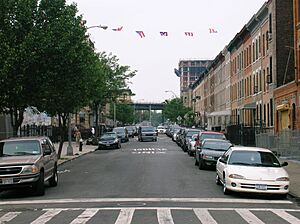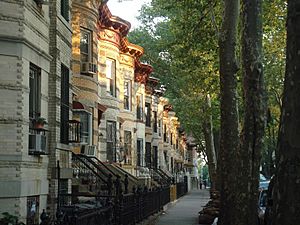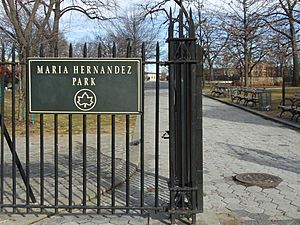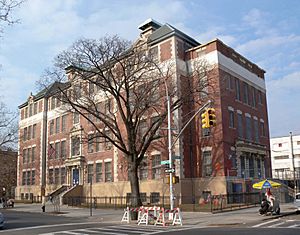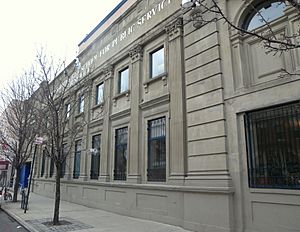Bushwick, Brooklyn facts for kids
Quick facts for kids
Bushwick
|
|
|---|---|
|
Neighborhood of Brooklyn
|
|
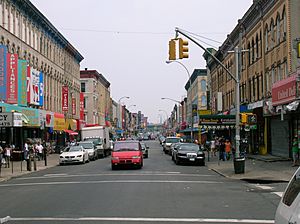
Knickerbocker Avenue in 2006. It is a main shopping street south of Maria Hernandez Park.
|
|
| Country | |
| State | |
| City | |
| Borough | |
| Community District | Brooklyn 4 |
| Area | |
| • Total | 6.1 km2 (2.34 sq mi) |
| Population
(2010)
|
|
| • Total | 129,239 |
| • Density | 21,320/km2 (55,230/sq mi) |
| Ethnicity | |
| • Hispanic | 67.0% |
| • Black | 18.5% |
| • White | 9.4% |
| • Asian | 3.9% |
| • Others | 1.1% |
| Economics | |
| • Median income | $33,162 |
| Time zone | UTC– 05:00 (Eastern) |
| • Summer (DST) | UTC– 04:00 (EDT) |
| ZIP Codes |
11206, 11207, 11221, 11237
|
| Area code | 718, 347, 929, and 917 |
Bushwick is a lively neighborhood in the northern part of Brooklyn, a borough of New York City. It shares borders with Ridgewood, Queens to the northeast and Williamsburg to the northwest. Other neighbors include East New York and Bedford–Stuyvesant.
The Dutch first settled Bushwick in the 1600s, calling it Boswijck. This name means "neighborhood in the woods." Over time, many different groups of people have made Bushwick their home. In the 1800s, German immigrants arrived. Later, in the 1900s, many Italian immigrants moved there. By the late 1900s, a large number of Hispanic immigrants came to Bushwick.
Today, Bushwick is part of Brooklyn Community Board 4. It has several ZIP Codes, including 11206, 11207, 11221, and 11237. The New York City Police Department's 83rd Precinct patrols the area.
Contents
Geography of Bushwick
Bushwick's boundaries mostly match those of Brooklyn Community Board 4. These borders are Flushing Avenue to the north and Broadway to the southwest. The neighborhood also borders Queens to the northeast and the Cemetery of the Evergreens to the southeast. An industrial area north of Flushing Avenue is sometimes called "Industrial Bushwick."
The center of New York City is actually located in Bushwick. You can find it on Stockholm Street, between Wyckoff and St. Nicholas Avenues.
History of Bushwick
Early Days and Dutch Settlement
In 1638, the Dutch West India Company bought the Bushwick land from the local Lenape people. In 1661, Peter Stuyvesant officially named the area Boswijck. This name means "neighborhood in the woods" in old Dutch. Bushwick was one of the last of the six original Dutch towns in New Netherland.
The first settlers arrived in 1660. They included French and Huguenot people, a Dutch translator, and an African man who had earned his freedom. They built their settlement around a church near where Bushwick and Metropolitan Avenues are today. The main road was Woodpoint Road, used by farmers to take their goods to the town dock.
The English took control of the six Dutch towns three years later. In 1683, they united them under Kings County. Many old Dutch records from Bushwick were lost when it joined Brooklyn in 1854.
By the early 1800s, Bushwick had four main villages: Green Point, Bushwick Shore, Bushwick Green, and Bushwick Crossroads. Bushwick Shore, later known as Williamsburg, grew very quickly. It became its own city in 1852 before both Bushwick and Williamsburg joined the City of Brooklyn in 1854.
Bushwick's Industries
When Bushwick was first settled, people mostly farmed food and tobacco. As New York City grew, factories for sugar, oil, and chemicals were built. The famous inventor Peter Cooper built his first glue factory in Bushwick.
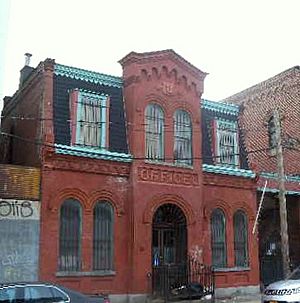
In the mid-1800s, many German immigrants moved to Bushwick. They helped create a large brewery industry. By 1890, there were 14 breweries in a small area, earning Bushwick the nickname "beer capital of the Northeast." The last big breweries, Schaefer's and Rheingold, closed in 1976. The William Ulmer Brewery building was made a city landmark in 2010.
Farmers and brewers worked together. Dairy farmers used leftover grain from the breweries to feed their cows. In return, they sold milk and other dairy products to people in Brooklyn.
Railways and Growth
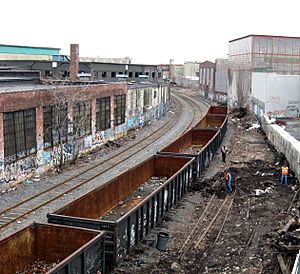
In 1868, the Long Island Rail Road built a line to Bushwick. This made it easier to move people and goods. Later, in the 1880s, elevated trains (called "els") were built. These lines, like the Broadway Elevated and Myrtle Avenue Elevated, connected Bushwick to Downtown Brooklyn and Manhattan. This led to a rapid growth in homes.
With successful breweries and easy train access, more European immigrants came to Bushwick. Some parts of the neighborhood became very wealthy. Brewery owners and doctors built fancy homes. Even New York mayor John Francis Hylan lived in Bushwick during this time.
Bushwick became a cultural center with theaters. The Amphion Theatre was one of the first in the country to use electric lighting.
The neighborhood was very prosperous between World War I and World War II. After World War I, many Italian Americans moved to Bushwick, joining the German community. By 1950, it was one of New York City's largest Italian American neighborhoods.
Many Italian families were from Sicily. They formed social clubs to keep their traditions alive. St. Joseph Patron of the Universal Church was a central church for the Sicilian community. It held several feasts each year. This church opened in 1923 because the Italian community was growing fast.
Changes and Challenges
After World War II, Bushwick's population changed. In 1960, almost 90% of residents were white. By 1970, this dropped to less than 40%. Many Puerto Ricans and African Americans moved into the area.
At the same time, Bushwick's economy changed. Breweries closed, and jobs were lost. In the 1960s, there were plans to rebuild parts of Bushwick, but they never happened. Many old buildings were torn down, leaving empty lots.
On July 13, 1977, a big blackout hit New York City. Bushwick was badly affected. Many stores were looted and burned, especially along Broadway. This event made Bushwick known for riots and damage. After the blackout, many middle-class residents left the area. New immigrants, especially from Hispanic America, continued to move in.
Even in the 1990s, Bushwick remained a poorer area. Many residents relied on public assistance.
Bushwick Today
Since the year 2000, Bushwick has become more popular. As housing prices in Manhattan and nearby Williamsburg increased, younger people and artists started moving to Bushwick. They found homes in renovated buildings and old warehouse lofts.
Bushwick now has a thriving artist community. Many art studios and galleries are located there. There are also "open studios" events where the public can visit artists' workspaces. A local news website, Bushwick Daily, covers community news, events, food, and art.
The city and state governments started the Bushwick Initiative to improve the neighborhood. They worked to fix housing problems and boost local businesses, especially along Knickerbocker Avenue. In 2019, a new plan was released to allow for more building development in certain areas.
People of Bushwick
Bushwick is a diverse neighborhood. Most residents are Latino, including many from Puerto Rico and the Dominican Republic. There are also growing numbers of people from Mexico and El Salvador.
In 2018, about 25% of Bushwick residents lived in poverty. The median household income was around $50,656. Many residents, about 55%, spend a large part of their income on rent.
Bushwick has the largest number of Hispanic Americans in Brooklyn. The neighborhood's main shopping streets are Knickerbocker Avenue, Myrtle Avenue, Wyckoff Avenue, and Broadway. These streets have many businesses that serve the different cultures in the community.
Hispanic Communities
Bushwick is a center for the Hispanic community in Brooklyn. After World War II, many Puerto Ricans moved to New York for better opportunities. They settled in areas like Bushwick and Williamsburg.
Salsa music, corner stores called bodegas, and Latin food are important parts of Bushwick's culture. The neighborhood has a large concentration of Hispanic Americans. Williamsburg and Bushwick even have their own local Puerto Rican Day Parade.
A campus of Boricua College and a branch of Popular Community Bank are in Bushwick. Make the Road New York, a Latino community group, also has a chapter here.
Homes in Bushwick
Bushwick has many types of homes, including apartment buildings and two- or three-family townhouses. There are also three New York City Housing Authority developments that provide homes for low-income residents. These developments are:
- Bushwick II CDA (Group E)
- Hope Gardens
- Palmetto Gardens
The average rent in Bushwick in 2022 was about $2,180. This was a big increase since 2006. About 19.6% of residents own their homes.
Fire Safety
The New York City Fire Department (FDNY) has several firehouses in and around Bushwick. These include Engine Company 271, Engine Company 277, Engine Company 218 (known as the "Bushwick Bomberos"), and Squad 252.
Post Offices and ZIP Codes
Bushwick is covered by several ZIP Codes: 11237, 11221, and 11207. The United States Postal Service operates three post offices in Bushwick: Wyckoff Heights Station, Bushwick Station, and Halsey Station.
Border with Ridgewood
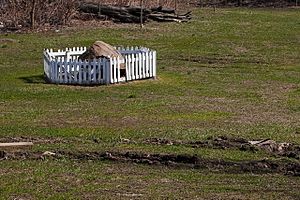
Bushwick is in Brooklyn, but it shares a border with Queens. This border caused confusion for a long time. In 1769, a special line was drawn through a spot known as the Arbitration Rock to settle disputes.
In 1925, the border was adjusted to follow the streets. This meant some houses changed from being in Queens to Brooklyn, or vice versa. Today, you can tell if an address is in Queens by a hyphen in the house number.
In 1980, the ZIP Codes for Ridgewood and Glendale in Queens were changed. They used to share a Brooklyn ZIP Code (11227) with Bushwick. After the 1977 blackout, residents wanted their own ZIP Code to be separate from Bushwick. So, Ridgewood and Glendale got 11385, and 11237 was assigned only to Bushwick.
Community Groups
Bushwick has many community groups that help residents. Some of these include:
- Coalition for Hispanic Family Services
- RiseBoro Community Partnership Inc
- East Brooklyn Congregations
- Make the Road New York
Parks and Fun Places
All parks in Bushwick are managed by the New York City Department of Parks and Recreation.
- Beaver Noll Park is a new park with seating and a play area for young children.
- Bushwick Park and Pool has a free public pool, a children's pool, basketball courts, and a playground.
- Bushwick Playground features handball courts, spray showers, and a children's playground.
- Green Central Knoll Park is on the site of an old brewery. It has a baseball field, sitting areas, and a playground.
- Heisser Triangle is a small park with a bronze war memorial.
- Irving Square Park has swings, a sandpit, a spray shower, and sports courts. It also has a public plaza and gardening space.
- Maria Hernandez Park is a large park with a renovated basketball court, handball court, fitness equipment, and a performance stage.
There are also community centers:
- Hope Gardens Multi Service Center offers programs for seniors, after-school activities, karate classes, and a summer camp for kids.
- Ridgewood Bushwick Youth Center is a place for youth activities.
Education in Bushwick
Bushwick has many schools. About 29% of adults over 25 have a college education. The percentage of students doing well in reading and math has been improving.
Bushwick has 33 public and private schools. This includes 14 public elementary schools, one charter school, four parochial schools, seven high schools, and one secondary school.
High schools in Bushwick:
- Academy for Environmental Leadership
- Brooklyn Latin School
- Bushwick Campus (which includes several smaller schools like Academy of Urban Planning)
- Bushwick Community High School
- Bushwick Leaders' HS for Academic Excellence
- EBC for Public Service-Bushwick
- Grand Street Campus (which includes High School for Legal Studies and others)
- MESA Charter High School
Combined middle and high schools:
- All City Leadership Secondary School
- Achievement First University Prep High School
The Roman Catholic Diocese of Brooklyn also runs Catholic schools in the area.
Libraries in Bushwick
The Brooklyn Public Library (BPL) has two branches in Bushwick. The DeKalb branch opened in 1905. The Washington Irving branch opened in 1923 and was the last Carnegie library built in Brooklyn.
There is also the Saratoga branch nearby, which opened in 1909. The Bushwick branch, which is actually in East Williamsburg, opened in 1903.
Getting Around Bushwick
Bushwick is well-connected by public transportation. The New York City Subway lines that run through Bushwick include the BMT Jamaica Line (J and Z train), the BMT Myrtle Avenue Line (M train), and the BMT Canarsie Line (L train). The Myrtle–Wyckoff Avenues station is a major hub.
Many New York City Bus lines also serve Bushwick, such as the B13, B20, B26, B38, B52, B54, B57, B60.
In 2010, about 68% of Bushwick residents used public transportation. Almost everyone (96%) lives close to a subway station.
Notable People from Bushwick
- 6ix9ine (born 1996), rapper.
- Eric Adams (born 1960), the 110th Mayor of New York City.
- Eugene Armbruster (1865–1943), photographer, illustrator, and historian.
- Jules de Balincourt (born 1972), contemporary artist.
- Bushwick Bill (1966–2019), rapper.
- William Black (c. 1902–1983), businessman who founded Chock full o'Nuts.
- Andre Charles (born 1968), graffiti artist.
- Maritza Davila (born 1963), politician.
- Ryan J. Davis (born 1982), theatre director.
- Danny Dias (c. 1983–2017), activist and TV personality.
- Camila Falquez (born 1989), portrait photographer.
- Jackie Gleason (1916–1987), actor.
- Rick Gonzalez (born 1979), actor.
- John Francis Hylan (1868–1936), former mayor of New York City.
- Williams Jerez (born 1992), baseball pitcher.
- Elle King (born 1989), singer.
- Timbo King, rapper.
- Charlie Murphy (1959–2017), comedian and actor.
- Eddie Murphy (born 1961), comedian and actor.
- Harry Nilsson, (1941–1994), singer/songwriter.
- O.C., rapper.
- Jeannie Ortega (born 1986), singer.
- Rosie Perez (born 1964), actress.
- Q-Unique, rapper.
- Anthony Ramos, (born 1991), actor and performer from Hamilton.
- Phil Rizzuto (1917–2007), baseball player and broadcaster.
- Chynna Rogers (1994–2020), rapper, disc jockey, and model.
- Salt (born 1966 as Cheryl James), rapper.
- Bernice Silver (1913–2020), puppeteer and activist.
- Obi Toppin (born 1998), basketball player for the New York Knicks.
- Mae West (1893–1980), actor.
See also
 In Spanish: Bushwick (Brooklyn) para niños
In Spanish: Bushwick (Brooklyn) para niños


